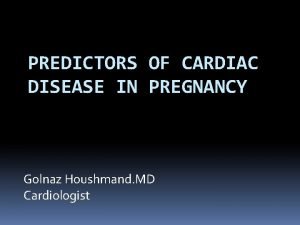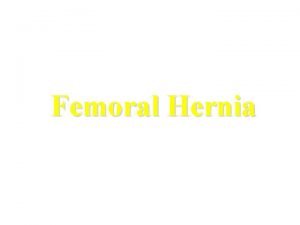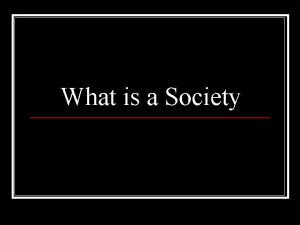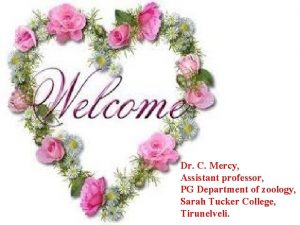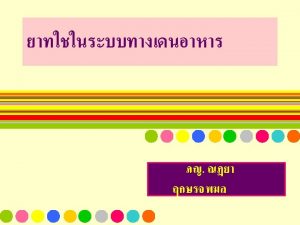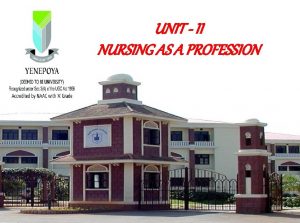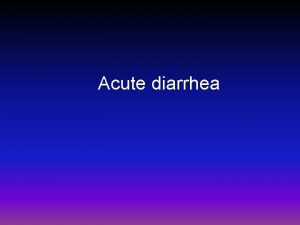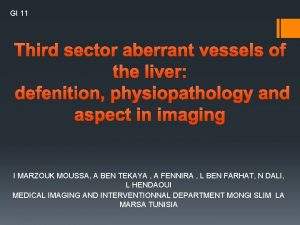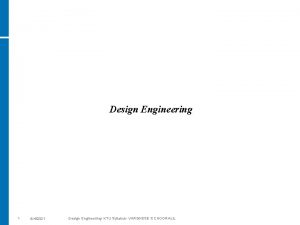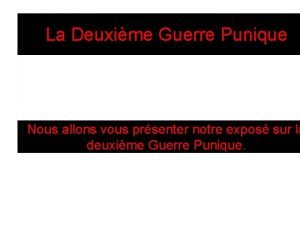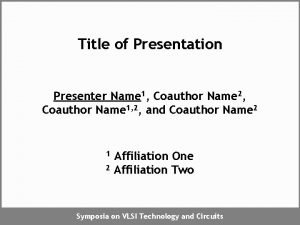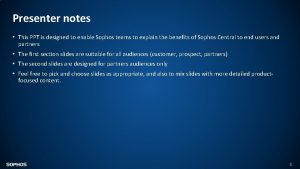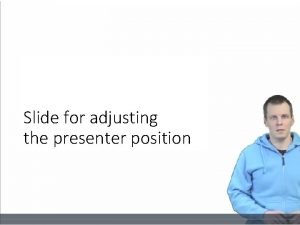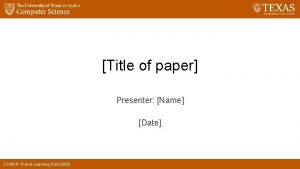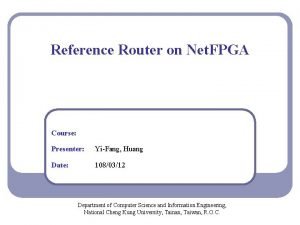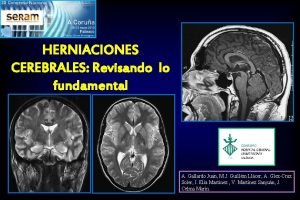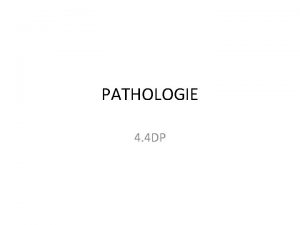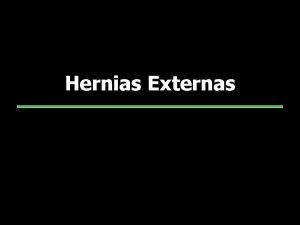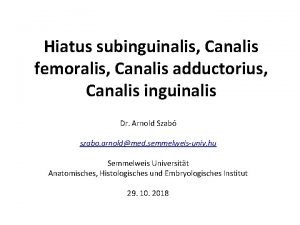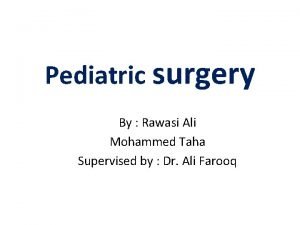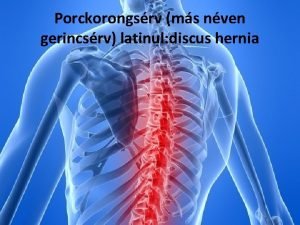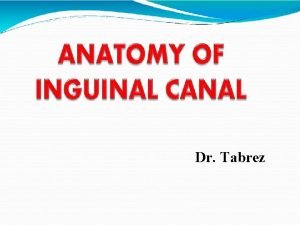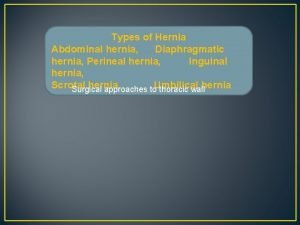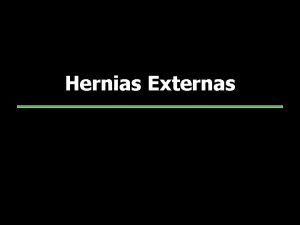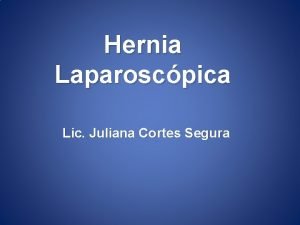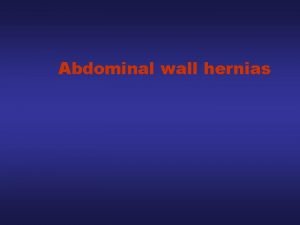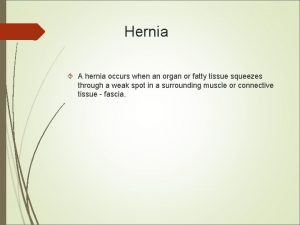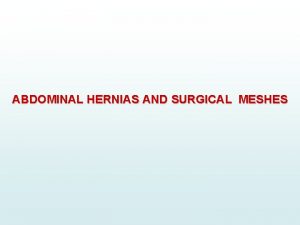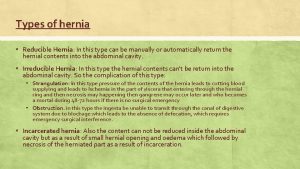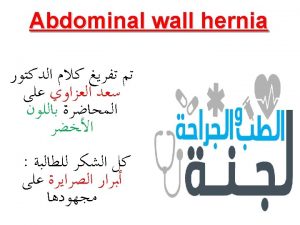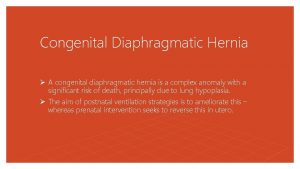HERNIA Presenter Golnaz Malekzadeh DEFENITION A hernia is




































































































- Slides: 100

HERNIA Presenter: Golnaz Malekzadeh

DEFENITION: Ø A hernia is an abnormal weakness or hole in an anatomical structure which allows something inside to protrude through. Ø It is commonly used to describe a weakness in the abdominal wall.


SIGNS AND SYMPTOMS The signs and symptoms of a hernia can range from noticing a painless lump to the painful, tender, swollen protrusion of tissue that you are unable to push back into the abdomen—possibly a strangulated hernia.

Hernias by themselves usually are harmless, but nearly all have a potential risk of having their blood supply cut off (becoming strangulated). Ø If the blood supply is cut off at the hernia opening in the abdominal wall, it becomes a medical and surgical emergency. Ø

CAUSES OF HERNIAS Any condition that increases the pressure of the abdominal cavity may contribute to the formation or worsening of a hernia. Obesity Heavy lifting Coughing Straining during a bowel movement or urination Chronic lung disease Fluid in the abdominal cavity Hereditary

COMPLICATIONS lordosis Ø Constipation Ø Urine retention Ø Difficulty in breathing Ø Compartment syndrome Ø And …. Ø

TYPES OF HERNIA 1. External 2. Internal 3. intermittent

CLINICAL TYPES OF HERNIA 1. reducible hernia is one in which the contents of the sac return to the abdomen spontaneously or with manual pressure when the patient is recumbent. 2. irreducible hernia is one whose contents or part of contents cannot be returned to the abdomen, without serious symptoms. hernias are trapped by the narrow neck

CLINICAL TYPES , CONTINUED… incarcerated hernia: is one whose contents cannot be returned to the abdomen, with severe symptoms. strangulated hernia: denotes compromise to the blood supply of the contents of the sac. incarcerated hernia and strangulated hernia are the two stages of a pathologic course Richter’s hernia (intestinal wall hernia ) a hernia that has strangulated or incarcerated a part of the intestinal wall without compromising the lumen. Sliding hernia is one in which the wall of a viscus forms a portion of the wall of the hernia sac. It is may be colon ( on the left), caccum (on the right) or bladder (on either side). Belongs to irreducible hernia Littre hernia: a hernia that has incarcerated the intestinal diverticulum (usually Meckel diverticulum).

HERNIA


EPIGASTRIC HERNIA Occurring between the navel and the lower part of the rib cage in the midline of the abdomen, these hernias are composed usually of fatty tissue and rarely contain intestine. Ø Men > Women Ø these hernias are often painless and unable to be pushed back into the abdomen when first discovered. Ø


UMBILICAL HERNIA 1 - Congenital 2 - Adault acquired

CONGENITAL UMBELICAL HERNIA Common in infants Ø Close spontaneously if <1. 5 cm Ø Repair if > 2 cm or if persists at age 5 years Ø Ø Repair primarily or with mesh

UMBELICAL HERNIA Ø Ø Women > men Risk factors Multiple Pregnancies Prolonged labor Ascites Large Abdominal Tumors-CT scan may be indicated for some patients Activities which result in strenuous physical activity(occupational or recreational : example weight lifting)

UMBELICAL HERNIA REPAIR Ø Morbitiy and incarceration rate considered to be high enough to warrant repair. One study showed incarceration twice that of femoral hernia. Ø Unfortunately, recurrence rates as high as 20 -28 % have been recorded. Ø patients with ascites ? ? ?
















. . Desktopventral herniaher. L 5175 umb 6






SPIEGHELIAN HERNIA

SPIGELIAN HERNIA Ø Ø Rare Hernia through subumbilical portion of semi-lunar line Difficult to diagnose –Abdominal pain or mass noted in abdominal wall. Frequently tender over area Clinical suspicion (location) CT scan Repair primarily or with mesh



INGUINAL HERNIA a protrusion of part of the contents of the abdomen through the inguinal region of the abdominal wall.








CLINICAL TYPES OF INGUINAL HERNIA indirect inguinal hernia: the internal inguinal ring the inguinal canal external inguinal ring scrotum Ø direct inguinal hernia: Hesselbach’s triangle Ø Pantaloon type Ø



RISK FACTORS Ø Ø Ø Ø Hereditary Smoking CDH Sedentary life style acquired weakness or defect of abdominal wall Increased intra abdominal pressure And ….

DIFFERENCES BETWEEN INDIRECT AND DIRECT HERNIA feature indirect age children, young people aged people pathway of protrusion coming down the inguinal canal, may enter the scrotum pass through Hesselbach’s triangle, rarely enter the scrotum contours of sac elliptic, pear-shaped semispheric, wide base Relationship of spermatic cord with sac Posterior to the sac Anterior and lateral to the sac Relationship of sac neck with inferior epigastric artery Sac neck is lateral to it Sac neck is medial to it Incarcerated incidence high low

PHYSICAL EXAM

SILK GLOVE SIGN Ø Palpation of hernia sac on spermatic cord






DIFFERENTIAL DIAGNOSIS Ø Ø lymph node lipoma saphenous varicosity mass

SURGERY COMPLICATIONS Recurrence Neuralgia Ilioinguinal Iliohypogastric Genitofemoral Lateral cutaneous Ischemic orchitis Injury to vas deference Wound infection Bleeding

FEMORAL HERNIA


FEMORAL HERNIA All are acquired. Ø Are secondary to an expanded femoral ring. Ø Probably due to increased intra abdominal pressure Ø Diagnosis by physical exam. Ø







DIFFERENTIAL DIAGNOSIS 1. indirect inguinal hernia 2. lipoma 3. groin lymph nodes 4. long saphenous varix 5. iliolumbar tuberculous abscess



















INCISIONAL HERNIA an abnormal protrusion of a viscus through the musculoaponeurotic layers of a surgical scar. Ø Swelling and mass in the incision Ø Rarely incarcerate Ø

ETIOLOGY Operative factors: - types of incision: vertical incision, transrectus incision, midline incision, standard paramedian incision - technique of closure - suture material Postoperative factors: - increased intra-abdominal pressure - Obesity - Malnutrition - Smoking -Immune dificiency

REPAIR Bring together fresh fascial edges after trimming sac Clean off fascial edges at least 1 cm back Close with interrupted or continuous sutures Even with careful technique recurrence rates as high as 50% have been reported


TAXIS 1 - Trendelenberg position 2 -morphin+ diazpam 3 -ice bag

TAXIS Contra indications: Fever Lococytosis Positive abdominal sign Erythema of skin

 Golnaz vahedi
Golnaz vahedi Dr golnaz badkobeh
Dr golnaz badkobeh Badkobeh
Badkobeh Femoral and inguinal hernia difference
Femoral and inguinal hernia difference Defenition of marketing
Defenition of marketing Honor defenition
Honor defenition Defenition of hydrosphere
Defenition of hydrosphere Sedentary defenition
Sedentary defenition Cocciq
Cocciq Hiatus defenition
Hiatus defenition What is earth switch
What is earth switch Input defenition
Input defenition What is the difference between courting and dating
What is the difference between courting and dating Defenition of lipids
Defenition of lipids Colonization defenition
Colonization defenition An allusion is a reference in a text to
An allusion is a reference in a text to Defenition
Defenition Prokinetic agents
Prokinetic agents Selective breeding defenition
Selective breeding defenition Nursing defination
Nursing defination Defenition of fever
Defenition of fever Liver defenition
Liver defenition Imperialism defenition
Imperialism defenition Design and engineering ktu solved problems
Design and engineering ktu solved problems Presenter logo
Presenter logo Oracle flex
Oracle flex Presenter company
Presenter company Presenter name
Presenter name Mitel 5000 hx
Mitel 5000 hx Presenter's name
Presenter's name Classroom presenter
Classroom presenter Ezra pound portrait d'une femme
Ezra pound portrait d'une femme Nous allons vous présenter notre exposé
Nous allons vous présenter notre exposé Rashmi choudhary presenter
Rashmi choudhary presenter Younique presenter ms name
Younique presenter ms name Presenter name
Presenter name Uno mobil
Uno mobil Company presenter
Company presenter Mitel presenter
Mitel presenter Fern presenter
Fern presenter Presenter media
Presenter media Ppt presenter based solutions
Ppt presenter based solutions Presenters name
Presenters name Helvetica neue ltstd-cn
Helvetica neue ltstd-cn Mitel presenter
Mitel presenter Adobe presenter 9
Adobe presenter 9 What is the name of the presenter
What is the name of the presenter Sales presenter
Sales presenter Name
Name Presenter's name
Presenter's name Name/title of presenter
Name/title of presenter Insert presenter
Insert presenter Presenter title
Presenter title Social media presenter
Social media presenter Mindfulschools
Mindfulschools Title of presenter
Title of presenter Presenter media
Presenter media Presenter media
Presenter media Presenter's name
Presenter's name Presenter vs facilitator
Presenter vs facilitator Name of presenter
Name of presenter Presenter title
Presenter title Cover letter for news presenter
Cover letter for news presenter Ai presenter
Ai presenter Presenter position
Presenter position Cue card moderator
Cue card moderator Classroom presenter
Classroom presenter Define:presenter
Define:presenter Cs presenter
Cs presenter What is the name of the presenter
What is the name of the presenter Presenter name
Presenter name Presenter over net
Presenter over net Presenter alternatives
Presenter alternatives Presenter verb
Presenter verb Presenter media
Presenter media Asos presenter
Asos presenter Presenter title
Presenter title Exemple dissertation histoire
Exemple dissertation histoire Presenter's name
Presenter's name Treasure presenter
Treasure presenter Presenter name
Presenter name Model view presenter
Model view presenter Oracle ctx
Oracle ctx Presenter pronunciation
Presenter pronunciation Presenter name
Presenter name Presenter
Presenter Aspiring presenter
Aspiring presenter It2teach
It2teach Adobe presenter
Adobe presenter Title of presenter
Title of presenter Presenter's name
Presenter's name Bochdalec hernia
Bochdalec hernia Herniaciones cerebrales
Herniaciones cerebrales Hypergranulatieweefsel
Hypergranulatieweefsel Islam
Islam Hiatus saphenus
Hiatus saphenus Manobra de landivar
Manobra de landivar Pediatric surgery
Pediatric surgery Epigastric hernia
Epigastric hernia Ligamento de gimbernat
Ligamento de gimbernat Flap valve mechanism of inguinal canal
Flap valve mechanism of inguinal canal

